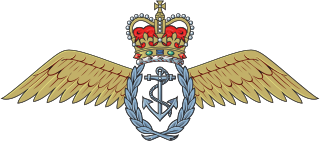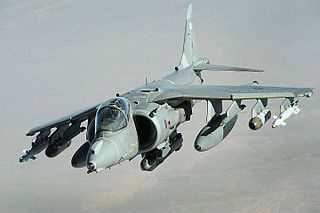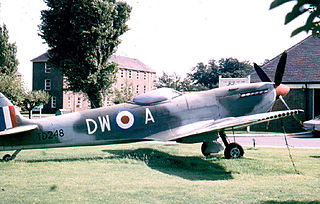
The Hawker Siddeley Harrier is a jet-powered attack aircraft designed and produced by the British aerospace company Hawker Siddeley. It was the first operational ground attack and reconnaissance aircraft with vertical/short takeoff and landing (V/STOL) capabilities and the only truly successful V/STOL design of that era.

The Fleet Air Arm (FAA) is the naval aviation component of the United Kingdom's Royal Navy (RN). The FAA is one of five RN fighting arms. As of 2023 it is a predominantly "rotary" force, with helicopters undertaking roles once performed by biplanes such as the Fairey Swordfish. It operates the F-35 Lightning II for maritime strike and the AW159 Wildcat and AW101 Merlin for commando and anti-submarine warfare.

The Harrier, informally referred to as the Harrier jump jet, is a family of jet-powered attack aircraft capable of vertical/short takeoff and landing operations (V/STOL). Named after a bird of prey, it was originally developed by British manufacturer Hawker Siddeley in the 1960s. The Harrier emerged as the only truly successful V/STOL design of the many attempted during that era. It was conceived to operate from improvised bases, such as car parks or forest clearings, without requiring large and vulnerable air bases. Later, the design was adapted for use from aircraft carriers.

Royal Air Force Kinloss, or more simply RAF Kinloss, is a former Royal Air Force station located near the village of Kinloss, on the Moray Firth in the north east of Scotland, UK.

The Rolls-Royce Pegasus, formerly the Bristol Siddeley Pegasus, is a British turbofan engine originally designed by Bristol Siddeley. It was manufactured by Rolls-Royce plc. The engine is not only able to power a jet aircraft forward, but also to direct thrust downwards via swivelling nozzles. Lightly loaded aircraft equipped with this engine can manoeuvre like a helicopter. In particular, they can perform vertical takeoffs and landings. In US service, the engine is designated F402.

The British Aerospace Harrier II is a second-generation vertical/short takeoff and landing (V/STOL) jet aircraft used previously by the Royal Air Force (RAF) and, between 2006 and 2010, the Royal Navy (RN). The aircraft was the latest development of the Harrier family, and was derived from the McDonnell Douglas AV-8B Harrier II. Initial deliveries of the Harrier II were designated in service as Harrier GR5; subsequently upgraded airframes were redesignated accordingly as GR7 and GR9.

Royal Air Force Henlow or more simply RAF Henlow is a Royal Air Force station in Bedfordshire, England, equidistant from Bedford, Luton and Stevenage. It houses the RAF Centre of Aviation Medicine, the Joint Arms Control Implementation Group (JACIG), elements of Defence Equipment and Support, and the Signals Museum. It formerly hosted light aircraft flying and 616 Volunteer Gliding Squadron. The Ministry of Defence announced on 6 September 2016 that the base is set to be closed following a consultation. Flying activity ceased in July 2020.

MoD Sealand, is a Ministry of Defence installation in Flintshire, in the northeast corner of Wales, close to the border with England. It is a former Royal Air Force station, active between 1916 and 2006.

Ministry of Defence St Athan or MOD St Athan, formerly known as Royal Air Force St Athan, or more simply RAF St Athan, is a large Ministry of Defence unit near the village of St Athan in the Vale of Glamorgan, southern Wales.

Royal Air Force Shawbury, otherwise known as RAF Shawbury, is a Royal Air Force station near the village of Shawbury in Shropshire in the West Midlands of England.
Marshall Group, formerly Marshall of Cambridge, is a British company headquartered in Cambridge, United Kingdom. Subsidiaries include Marshall Aerospace, an aircraft maintenance, modification, and design company located at Cambridge City Airport. Other subsidiaries are Marshall Land Systems, Marshall Slingsby Advanced Composites, Marshall Fleet Solutions, Marshall Futureworx, Marshall Skills Academy and Marshall Property. Marshall also owns and operates the airport itself.

PAL Airlines is a Canadian regional airline with headquarters at St. John's International Airport in St John's, Newfoundland and Labrador, Canada. PAL operates scheduled passenger, cargo, air ambulance and charter services. PAL is the commercial airline arm of the PAL Group of Companies. In addition to its head office, it also has bases in Halifax, Nova Scotia, Happy Valley-Goose Bay, and Montreal, Quebec. PAL is the second largest regional airline operator in Eastern Canada next to Jazz Aviation.

St Athan is a village and community in the Vale of Glamorgan in South Wales. The village and its parish church are dedicated to Saint Tathan. The church dates to the 13th–14th century, though an earlier church was dated to the Norman period. The village and the adjacent dormitory village of Eglwys Brewis are known primarily for the MOD St Athan RAF base. There are two pubs in the village, as well as a football team at St Athan Football Club and the St Athan Golf Club. The community includes West Aberthaw.

Aircraft Inspection, Repair & Overhaul Depot Sdn Bhd or AIROD is a Malaysian aerospace company engaged in providing aircraft maintenance, repair and overhaul (MRO) services. The name AIROD is an acronym that stands for Aircraft Inspection, Repair & Overhaul Depot.

The Defence Support Group (DSG) was an executive agency and wholly owned trading fund of the Ministry of Defence in the United Kingdom. It was established on 1 April 2008 by the merger of the Defence Aviation Repair Agency and the Army Base Repair Organisation. It was created under The Defence Support Group Trading Fund Order 2008. Part of the group was sold to Babcock International on 31 March 2015, while the remainder became the Defence Electronics and Components Agency (DECA) on 1 April 2015.
Hatfield Aerodrome was a private airfield and aircraft factory located in the English town of Hatfield in Hertfordshire from 1930 until its closure and redevelopment in the 1990s.
Royal Air Force Rhoose, or more simply RAF Rhoose, is a former Royal Air Force satellite station located near Rhoose, 10 miles (16 km) south west of Cardiff and 2 miles (3 km) east of RAF St Athan, Vale of Glamorgan, Wales. It was first used by an Operational Training Unit in April 1942, as additional space, until May 1943. The airfield then remained unused until February 1944, when an Air Gunnery School operated out of RAF Rhoose until August 1944. It was then placed into care and maintenance until transferred to RAF Maintenance Command in November 1944. After the Second World War, the airfield became a sub-site of a Maintenance Unit. The MU and airfield closed in 1948.

Boeing UK is a subsidiary of Boeing that operates in the United Kingdom and Republic of Ireland.

The Joint Aircraft Recovery and Transportation Squadron (JARTS), informally known as Crash and Smash, is a combined Royal Navy and Royal Air Force squadron that is tasked with the recovery and surface transportation of aircraft under the aegis of the British military framework. The squadron operates worldwide, and recovering aircraft from post-crash incidents is a large part of their work. Whilst they are a component of the British military, they may be asked to attend and recover aircraft from non-military incidents as they have a Memorandum of Understanding with the UK's Air Accident Investigation Branch (AAIB).
















